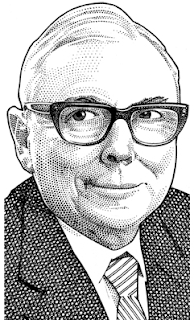-->
Getting Help Like Munger: How to Collaborate to Acquire New Mental Models & Destroy Ideas.
Charlie Munger has a
tip to help those interested in applying his mental models: "Quickly
eliminate the big universe of what not to do, follow up with a fluent,
multidisciplinary attack on what remains, then act decisively when, and only
when, the right circumstances appear."
 |
| Charlie Munger. |
The
Chronicle of Higher Education recently published a piece that is
instructive on how to heed Munger’s advice.
Sean Pue, assistant
professor of South Asian literature, was working on analyzing Urdu poetry. The
process of analyzing was difficult and time consuming. He wanted to use
computational resources to automate and speed up his analysis of the poetry’s
internal meter. Unlike many humanities scholars, Pue had a bit of an edge: he
was already a part of a fledgling digital humanities movement. So, he could use
code. But he wasn’t proficient enough to tackle the complexities of Urdu
poetry, which turned out to be what computer programmers call "combinatorially
explosive.”
Luckily, Mr. Pue has
a daughter. And his daughter has a best friend. The two take a ballet class
together. And the daughter’s best friend’s mom, Tracy Teal, is a microbial
ecologist who works at the same university. The parents struck up a
conversation about Urdu poetry and Pue’s difficulties. And Teal saw analogies
between Mr. Pue’s work and the way DNA causes proteins to form. So she offered
to help.
It turned out that
Urdu poetry was considerably more complicated and less predictable than the
process by which DNA makes RNA protein (not a huge surprise, given Munger’s
trenchant insight about another human behavior, economics, “Behavioral economics,
how could economics not be behavioral? If it isn't behavioral, what the hell is
it?”).
I won’t spoil the
story for you, or the interesting interdisciplinary ramifications
collaborations like these—which are increasing in frequency, by the way—the
article mentions. It’s a good piece, well worth reading. I will mention that
the piece cites Brandeis vice provost John Unsworth as saying that both biology
and the humanities historically had "a certain disdain for quantitative
methods as being an oversimplification of the wonderfully idiosyncratic and
messy problems presented by living nature."
It was a disposition
both needed to overcome. Sharing that (bad) trait and sub-optimal history,
though, may help academics in both fields share a desire to overcome such
intellectual obstinacy.
And it might bring
researchers together in fecund ways.
Pue & Teal's story illustrates how collaboration can
help us learn and use new models. Collaboration can also help us destroy ideas that are no
longer useful. Lots of that happened in one of higher education’s most
remarkable building MIT’s building
20. (It was also remarkably ramshackle: Fred
Hapgood wrote of the building: “The edifice is so ugly...that it is impossible not to admire it, if
that makes sense; it has 10 times the righteous nerdly swagger of any other
building on campus, and at MIT any building holding that title has a natural
constituency.”) Made of wood because steel was in such short
supply in 1943, it was destined to be razed immediately following WWII but
outlived its intended expiration date by more than 50 years.
 |
| MIT's building 20, circa 1946. |
Building 20's unexpectedly long lifespan was attributable to it being a hospitable place for creativity. And that it housed, and was loved by, some of the 20th century’s brightest minds who came up with some of the 20th century's most groundbreaking ideas. Architecture
author Stewart Brand asked the people who worked in building 20 what was so
special about it. And they told him: “The ability to personalize your space and
shape it to various purposes. If you don’t like a wall, just stick your elbow
through it….We feel our space is really ours. We designed it; we run it. The
building is full of small microenvironments, each of which is different and
each a creative space.”
MIT professor Paul Penfield observed, “Its
‘temporary nature’ permitted its occupants to abuse it in ways that would not
be tolerated in a permanent building. If you wanted to run a wire from one lab
to another, you didn’t ask anybody’s permission — you just got out a
screwdriver and poked a hole through the wall.” Penfield later complied many of
the most compelling anecdotes about the building and the team of geniuses it
housed.
What’s interesting
from a Munger-like standpoint, is how the physical building—normally sacrosanct
(the college I work for won’t allow me to paint my own walls, even if I pay for
the paint and perform the labor myself, despite the fact they look like this:
that’s right, they painted around my desk. Then moved it.)—wasn’t in building 20.
 |
| My office wall. Where my desk once was. |
that’s right, they painted around my desk. Then moved it.)—wasn’t in building 20.
People had control
over how to use the building, not the other way around. And that led to amazing
results. While Jerrold
Zacharias was working on designing the first atomic clock in the facility,
for example, he “arranged to have sections of two floors removed so he could
assemble a tall cylinder that was part of his design.”
Like Jesus who told
his contemporaries that it is “not that which goeth into the mouth that
defileth a man; but that which cometh out,” Munger’s perspective asks people to
worry more about their mental rather than physical architecture. In Jesus’
parable (at least according to Matthew’s retelling), “whatsoever entereth in at
the mouth goeth into the belly, and is cast out into the draught…But those
things which proceed out of the mouth come from the heart; and they defile the
man.” Munger, I think, isn’t as concerned with the walls in his buildings as
with the minds those buildings house.
But he proposes a
similar process to building 20 for optimal mental growth: regularly blow the
place up until it’s hospitable to good ideas. “If Berkshire had made a modest
progress, a good deal of it is because Warren and I are very good at destroying
our own best-loved ideas. Any year that you don't destroy one of your
best-loved ideas is probably a wasted year.”
Munger's thinking suggests getting in the habit of
destroying ideas, of reworking our mental architecture, until it no longer gets in the way of our creativity. Finding a friend or network of professional collaborators who
can help with the destruction process—and in the process of cultivating and
using mental models—is also a wonderful idea. It worked for Munger &
Buffett on a large scale over many years, for the scholars in building 20, and
so far so good for Mr. Pue & Ms. Teal.






























